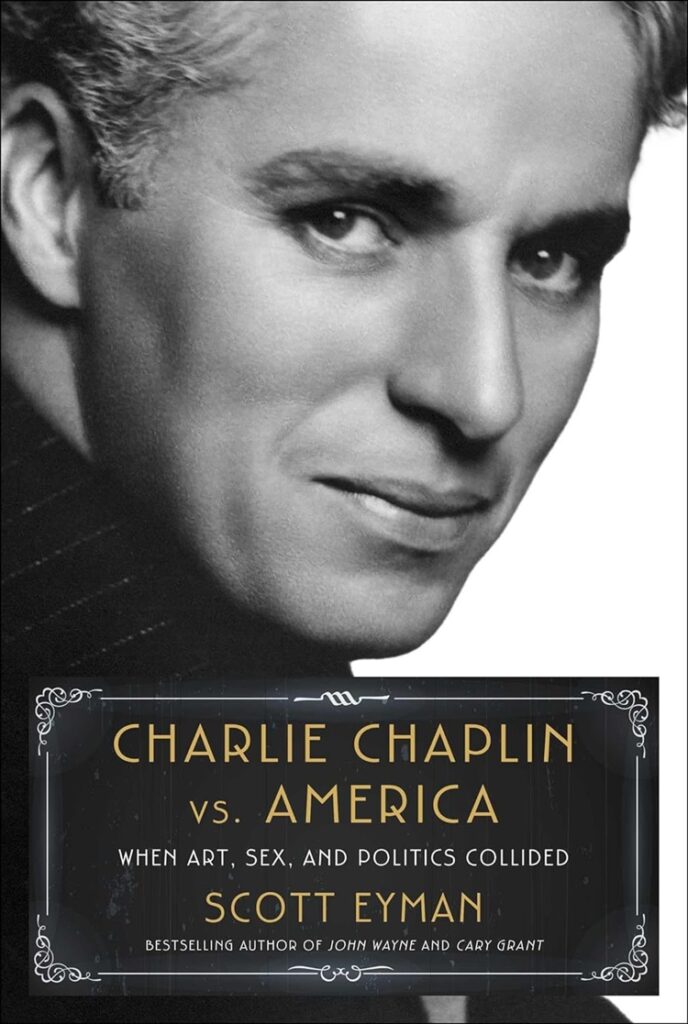
Growing up I didn’t really get a chance to watch many Charlie Chaplin movies. So it wasn’t until my early 20s, after watching The Kid (1921) and the biopic Chaplin (1992) with Robert Downey Jr, that I became aware of the Chaplin genius. I found his work funny and he himself interesting. A fascination grew and I wondered what the man behind the Little Tramp was really like. With so many books to choose from I put the subject off for many years until I got the chance to read Scott Eyman’s new biography from Simon and Schuster titled Charlie Chaplin vs. America: When Art, Sex, and Politics Collided. Being familiar with Eyman’s previous books and further enticed by the title, I jumped at the chance to finally take a closer look at the life of Charlie Chaplin.
Eyman covers a lot of ground in his 416 pages while keeping a good, readable, pace. We get an overview of Charlie’s young life: from his poor childhood, living with his brother and mother before she took ill, his time living on the streets and avoiding landlords to his days on stage before finding his true calling in the silent movies. Eyman doesn’t go into much detail about Charlie’s early life or many of his movies. Choosing to focus on his later works such as Modern Times, The Great Dictator, Monsieur Verdoux and Limelight.
Eyman uses those movies to help analyze and explore where Chaplin was during those stages of his life, who he was married to, and how those films reflected and affected him. He points out how the media pounced on him for his marriages and divorces from women younger than himself and how those women tried to portray him to the world. Highlighting how Modern Times and The Great Dictator caused the gossip columnists, especially Hedda Hopper and Ed Sullivan to turn their full ire on Chaplin, citing those pictures as overtly pro-socialist. Eventually gaining the attention of J. Edgar Hoover and then HUAC, who would eventually force him and his wife Oona out of the country. Only returning after many years living in Switzerland with Oona and his children to accept an honorary Oscar in 1972 before his passing in 1977.
Chaplin vs. America has a good flow and is entertaining throughout. Eyman does a fine job utilizing Chaplin’s My Autobiography and directly citing sources close to him without getting bogged down by too many document reprints or overly long personal statements. Eyman’s approach in this biography differs from others as his focus is on Chaplin’s troubles and battles with the government and media. Noting how Hoover and the Hollywood gossip columnists saw his work as immoral and socialist propaganda, pushing hard for him and his movies to be banned in the United States. Their efforts did actually aid in his movies being pushed aside and not shown as often or as widely for many years.
Despite its subtitle, the book isn’t a scandal sheet filled with perverted little secrets and dirty laundry; neither is it the most detailed study of Chaplin’s overall life. It is, however, a fascinating, fact-based, and well-researched portrait of Chaplin as he stood for what he believed in during a dark time in American political history. And for those wondering, there’s a good photo section that helps put faces to some names referenced throughout Eyman’s great work.
Chaplin vs. America: When Art, Sex, and Politics Collided is an essential read for fans of Chaplin and fits well alongside David Robinson’s in-depth Chaplin: His Life and Art and Charlie Chaplin’s My Autobiography. After reading Scott Eyman’s book, I went on a bit of a deep dive into Chaplin’s life, reading the two other books mentioned above and watching many of Chaplin’s movies. I feel that within those three books one gets a pretty complete idea of the life, mind, and art of the man behind the Little Tramp.